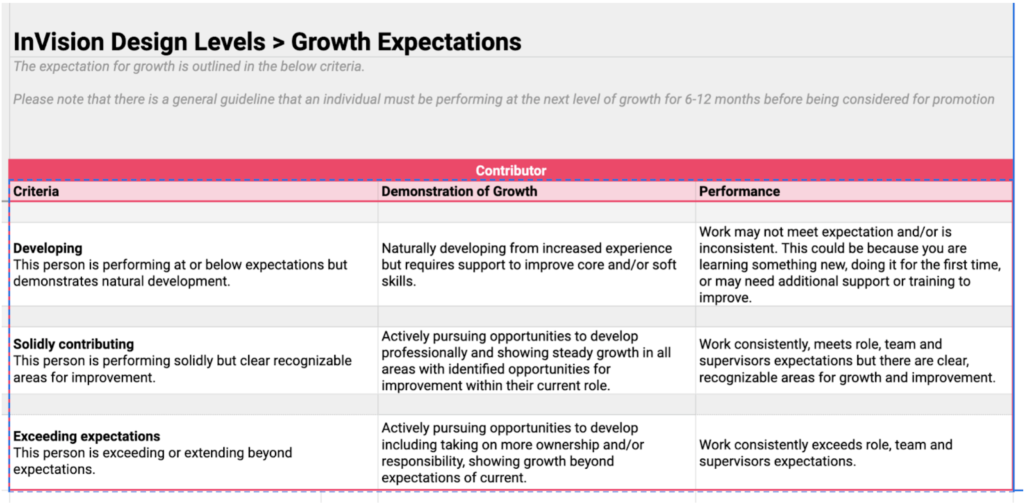The people-centered focus needs to be more than reactive, solving acute needs. Going through the exercise of mapping the designer journey, allows us to uncover some of the most salient moments that matter in opportunities for personal growth and professional development.
There are plenty of ways in which this can be done in low fidelity with the exact same results as a detailed high fidelity artifact. The goal is to be intentional about the overarching story so that you are thinking about the journey in broader experiential strokes and identifying the moments that matter.
The focus areas often fall into these categories:
- Attraction: What are the ways in which designers are finding your company
- Recruitment: How is your organization acquiring new talent
- Onboarding: What do the designers first 90 days feel like
- Retention and development: How is talent being nurtured so they stay and flourish throughout the arc of their own professional maturity
- Separation: When it’s time to part how to do so in a way that feels as intentional as the rest of the experience, for better or for worse
Attraction
Throughout the journey, the touchpoints are the tangibles you can identify designers connecting with. When considering those touchpoints, an important question to ask is, “what are the ways in which your design org presents itself?”
There is a myriad of ways talent can find their way to your organization. How your company is showing up will be what resonates. Oftentimes you will hear people say “we are shipping our org chart,” the same can be said for the experience of a potential hire through the attraction and recruiting experience: does it feel connected, accessible, diverse, and inclusive? Or siloed, disjointed, monolithic, and exclusive?
With the demand for design talent at an all-time high, these questions and the answers to them will be driving more and more decision making. Whatever it is your organization is or isn’t striving for will be what the world sees, so be intentional.
Recruitment
There’s long been a funnel problem in recruiting for designers. In the past, it has been said that there wasn’t enough talent, or, big tech is eating up all the good talent and so on. Taking a much more expansive approach to recruit, choosing to not go down the traditional path for what it takes to make someone a great designer is an important place to start.
Breaking mental models is hard. Design Ops tends to be a land for generalists. The same can be said for Design in general, we as designers have prided ourselves on that role of “misfit, artist, creative, nonconformist” but now that our people are being recognized as a necessary key to driving good business how do we force ourselves to a place of self-awareness and widen our pool? Over time organizations have come to recognize that process design is also design, hence the recognition of the need for DesignOps, – it’s about how people approach systems and problem-solving.
There are different reasons and excuses as to why it’s hard to find good talent (like, let’s start with what is your definition of good – chances are everyone’s definition is a little bit different) and so much of it lies in the ability to be proactive vs. reactive – a luxury in and of itself. When considering how to open up the funnel to allow for a diverse pool of candidates consider how much easier it is to be in a place where you have space to even think in this way. This is why recruiting should be happening at all levels at all times in your organization, not just when something is on fire or valuable talent has taken a job with the competition.
When you’re thoughtful about the type of talent you want to hire, and committed to all types of diversity, you’ll find it much easier to meet people where they are, and avoid going down the same paths again and again.
Authenticity in your talent “brand” will be a major representation of your organization to the world. How do you appear? Is the community message that is being presented coming from the bottoms up, or the top down? However, you present your organization will become increasingly apparent to the world at large if it is not built by those who are the makers.
Role Definition
Clarity in role definition plays a critical role in not only recruiting for the role but also as a reference when evaluating growth within the organization. Creating clear job expectations at each level of the specific role will help set a baseline of expectations as well as define a pathway to the next level.
So let’s talk about how design ops can help once a new employee joins.
Onboarding
There are many ways in which someone can land in a company. These are organizations that have invested in their Employee Experience and know that starting a new job is hard. Additionally, more and more people are starting jobs not in an office, but at home, alone. Whether your experience is in real life (IRL) or not in real life (NIRL) being mindful of what that experience feels like to someone new who is starting all over again will allow you to design an onboarding program that is steeped in empathy for the unknowns. Know that the designers’ first touchpoint in your organization is the first time they actually land in the culture of your organization, and culture design is inextricably tied to the role of Design Operations and the overarching experience.
Starting all over again, being the newbie is hard. Everything you thought you knew goes out the window. It’s like going from a senior in high school to a freshman in college — you’re downgraded real quick and have to prove your value and learn the ropes from scratch, feeling like an imposter all over again. Empathy for this experience will allow you to create onboarding plans for new hires, gathering all the helpful hints and connections to ease that friction. Time to feeling successful and having some sort of “win” should be no more than 3 months for any new hire.
Retention and development
As a design lead, throughout your career, you will likely manage and build many different kinds of design teams. Pride yourself on being intentional about building teams knowing that implicit in the role of Design Operations is culture creation. Why do healthy teams matter? Because great teams = great work. At frog, we would kick off projects with what was called a “team leap,” which established team and individual purpose. This process had two key components: establishing the essential goal of the team, and identifying what everyone hopes to get out of the project. Framing each project as an opportunity for individual growth helps people feel motivated. Clarity of team purpose helps drive alignment and empowerment. As a team, we would hold each other accountable to these “playbooks” as well as stay mindful of everyone’s established personal and professional parameters.
Career paths
Be sure to set clear expectations around what growth looks like. At InVision I built a framework based on:
- Criteria
- Demonstration of Growth
- Performance

Levels
- Core skills defined – not everyone is a unicorn, and that’s OK. It’s important to define the core skills needed to fulfill the basic requirements as well as what might be considered complementary and/or specialized skill sets.
- Professional development & Performance: Do not separate the personal from the professional, allow for holistic development
Knowing the top three reasons people leave companies are centered around lack of career path and reason for being, a framework for the Personal Professional Mission (PPM) that could orient designers at every stage in their career. Over time the overarching designer journey would be the foundation for one’s broader personal, professional journey. This approach can organically foster a sense of belonging, connection, and community. Additionally, putting in place a support system that sets a clear path for growth and development can increase discipline in practice. In short, fulfilled people = great work.
Separation
All good things must come to an end, the same can be said for the phrase “this too shall pass.” The peak-end rule is a cognitive bias that impacts how people remember past events. Intense positive or negative moments (the “peaks”) and the final moments of experience (the “end”) are heavily weighted in our mental calculus. While important milestone moments will stick, recency bias forces how things ended to stick even more, so how things end matter in the emotions they carry with them into the world, and share. Regardless of the reason why parting ways should be as intentional as any other moment in their journey.

I’m a Design Operations leader with a passion for developing operational programs, processes, and platforms as well as the ability to manage multiple programs, think holistically, and strategically while being able to tactically execute. Central to my role is developing a shared understanding that Design Ops is not just about design, it is a lever in which design at scale can be implemented and change management supported.

